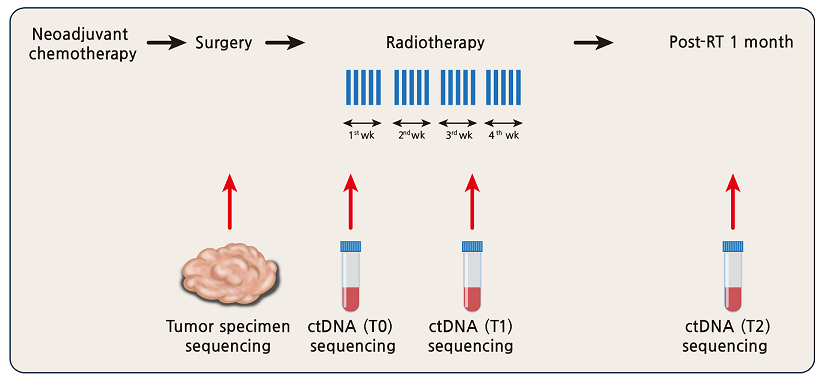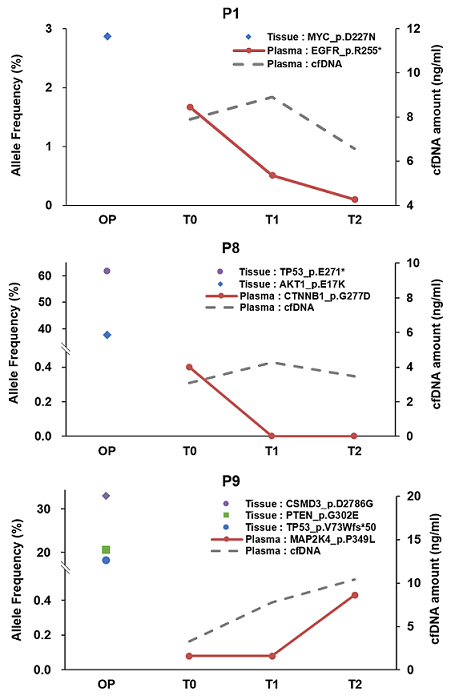글로벌 연구동향
방사선종양학
- 2021년 10월호
[Breast Cancer Res Treat.] Dynamics of circulating tumor DNA during postoperative radiotherapy in patients with residual triple-negative breast cancer following neoadjuvant chemotherapy: a prospective observational study.성균관의대 / 김해영*, 김연정
- 출처
- Breast Cancer Res Treat.
- 등재일
- 2021 Aug
- 저널이슈번호
- 189(1):167-175.
- 내용
Abstract
Background: This study was performed to evaluate circulating tumor DNA (ctDNA) kinetics during postoperative radiotherapy (PORT) in patients with residual triple-negative breast cancer (TNBC) at surgery following neoadjuvant chemotherapy (NAC).Methods: Stage II/III patients with post-NAC residual TNBC who required PORT were prospectively included in this study between March 2019 and July 2020. For 11 TNBC patients, next-generation sequencing targeting 38 genes was conducted in 55 samples, including tumor tissue, three plasma samples, and leukocytes from each patient. The plasma samples were collected at three-time points; pre-PORT (T0), after 3 weeks of PORT (T1), and 1 month after PORT (T2). Serial changes in ctDNA variant allele frequency (VAF) were analyzed.
Results: Somatic variants were found in the tumor specimens in 9 out of 11 (81.8%) patients. Mutated genes included TP53 (n = 7); PIK3CA (n = 2); and AKT1, APC, CSMD3, MYC, PTEN, and RB1 (n = 1). These tumor mutations were not found in plasma samples. Plasma ctDNA variants were detected in three (27.3%) patients at T0. Mutations in EGFR (n = 1), CTNNB1 (n = 1), and MAP2K (n = 1) was identified with ctDNA analysis. In two (18.2%) patients, the ctDNA VAF decreased through T1 and T2 while increasing at T2 in one (9.1%) patient. After a median follow-up of 22 months, no patient showed cancer recurrence.
Conclusion: Among patients with post-NAC residual TNBC, more than a quarter exhibited a detectable amount of ctDNA after curative surgery. The ctDNA VAF changed variably during the course of PORT. Therefore, ctDNA kinetics can serve as a biomarker for optimizing adjuvant treatment.


Affiliations
Haeyoung Kim # 1 , Yeon Jeong Kim # 2 , Donghyun Park 2 3 , Woong-Yang Park 2 4 , Doo Ho Choi 5 , Won Park 5 , Won Kyung Cho 5 , Nalee Kim 5
1 Department of Radiation Oncology, Samsung Medical Center, Sungkyunkwan University School of Medicine, 81 Irwon-Ro, Gangnam-gu, Seoul, 06351, Republic of Korea. haeyoung0131.kim@samsung.com.
2 Samsung Genome Institute, Samsung Medical Center, Seoul, South Korea.
3 GENINUS Inc, Seoul, South Korea.
4 Department of Molecular Cell Biology, Sungkyunkwan University School of Medicine, Suwon, South Korea.
5 Department of Radiation Oncology, Samsung Medical Center, Sungkyunkwan University School of Medicine, 81 Irwon-Ro, Gangnam-gu, Seoul, 06351, Republic of Korea.
# Contributed equally.
- 키워드
- Breast neoplasms; Circulating tumor DNA; Radiotherapy; Triple Negative Breast Neoplasms.
- 연구소개
- 선행항암화학요법 후에도 완전관해를 이루지 못하고 수술 시 잔존 종양이 확인된 삼중음성유방암 환자는 전신 전이율 및 종양 재발율이 높아 예후가 불량한 것으로 알려져 있습니다. 혈액에서의 순환종양 DNA는 임상적인 암의 재발이 발견되기 전부터 환자의 혈액에서 검출될 수 있습니다. 따라서, 순환종양 DNA 분석을 통해 통상적인 임상 검사보다 미리 종양의 재발을 예측할 수 있을 것으로 기대할 수 있습니다. 그러나, 실제 임상에서 이를 적용한 결과는 충분하지 않고 특히 방사선치료에 따른 혈중 순환종양 DNA의 변화 패턴에 대한 연구는 아주 드뭅니다. 본 연구는 선행항암화학요법 및 수술을 시행한 삼중음성유방암 환자에서 방사선치료 전/치료 중/치료 후 환자의 혈액에서 순환종양 DNA를 분석하였습니다. 전체 환자 중 27.3%에서 방사선치료 전 채취한 혈액에서 순환종양 DNA가 검출되었고 방사선치료에 따른 시점에 따라 환자마다 다양하게 검출 패턴이 변하였습니다. 이번 연구는 삼중음성유방암 환자에서 보조 방사선치료 후 예후를 예측함에 있어 혈중 순환종양 DNA 분석을 활용할 수 있는 기본 근거를 제공한 선도적인 연구라고 할 수 있습니다.
- 덧글달기








편집위원
선행항암화학요법에 완전관해를 보이지 않는, 수술 후 방사선치료를 받는 삼중음성 유방암 환자에서 ctDNA의 유전자변이 변화양상을 분석한 논문
덧글달기닫기2021-10-05 15:39:34
등록